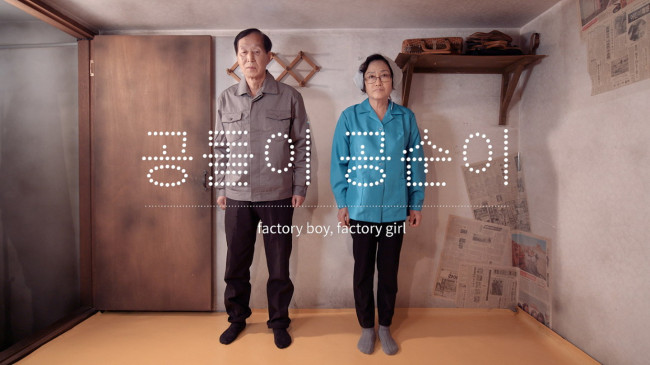What’s in a word? Quite a lot for Nils Clauss, a video artist and documentary filmmaker who has used terms coined during Korea’s industrial rise to study the turbulent period in his latest work, “Bikini Words.”
The film shows people who worked in factories during the period, who playfully yet plaintively illustrate the terms while giving explanations of their meaning and recollections of that time via voice-over.
The film shows people who worked in factories during the period, who playfully yet plaintively illustrate the terms while giving explanations of their meaning and recollections of that time via voice-over.

Clauss made the video for the Geumcheon District Office in Seoul, which is planning an exhibition platform in nearby Gasan Digital Complex Station.
“The exhibition builds an overall picture on how Geumcheon District has been shaped during the ‘miracle years’ of South Korea’s rapid economic growth starting in the 1960s all the way up to the mid 1990s,” said Clauss in a written introduction to his work.
“Even though this was the time which shaped South Korea into a wealthy and developed country, that period also left scars, and human rights were often disregarded while prioritizing economic success.”
Nils took his inspiration for the video from the “G Index,” a list of terms coined by factory workers in the 1970s and ’80s compiled by Yoo Hae-yeon, a researcher at the Soongsil School of Architecture.
The video’s name comes from “bikini closet,” one of the terms in the list, which refers to a cheap closet-type clothes hanger covered in fabric.
“This index is so fascinating as it’s not only of value linguistically, but also as a unique social historical document that sheds light into the life of the so-called ‘factory boys’ and ‘factory girls’ of that period and the harsh conditions they worked under,” explained Clauss. “The words also emphasize the importance of education for the factory workers, and the role fashion played as a form of escapism in the short periods of leisure time they enjoyed.”
The video was filmed in an exhibition space run by the district office called Guro Industrial Complex Labor House. The layout features small rooms that are similar to the accommodation of factory workers of the time.
“They (the district office) often have school visits there and encourage kids to come in and experience the rooms and that period by putting on old clothing and then taking photos of themselves in those rooms which resemble the ‘beehive’ accommodation the factory workers used to live in,” said Clauss. “So this initiated the idea to place people in the rooms and give each room a theme connecting it with a word from the G Index.”
The video was chosen for the Lift-Off Film Festival in the United Kingdom and is also a staff pick on Vimeo. To see the work online, visit https://vimeo.com/151000182.
By Paul Kerry (paulkerry@heraldcorp.com)
“The exhibition builds an overall picture on how Geumcheon District has been shaped during the ‘miracle years’ of South Korea’s rapid economic growth starting in the 1960s all the way up to the mid 1990s,” said Clauss in a written introduction to his work.
“Even though this was the time which shaped South Korea into a wealthy and developed country, that period also left scars, and human rights were often disregarded while prioritizing economic success.”
Nils took his inspiration for the video from the “G Index,” a list of terms coined by factory workers in the 1970s and ’80s compiled by Yoo Hae-yeon, a researcher at the Soongsil School of Architecture.
The video’s name comes from “bikini closet,” one of the terms in the list, which refers to a cheap closet-type clothes hanger covered in fabric.
“This index is so fascinating as it’s not only of value linguistically, but also as a unique social historical document that sheds light into the life of the so-called ‘factory boys’ and ‘factory girls’ of that period and the harsh conditions they worked under,” explained Clauss. “The words also emphasize the importance of education for the factory workers, and the role fashion played as a form of escapism in the short periods of leisure time they enjoyed.”
The video was filmed in an exhibition space run by the district office called Guro Industrial Complex Labor House. The layout features small rooms that are similar to the accommodation of factory workers of the time.
“They (the district office) often have school visits there and encourage kids to come in and experience the rooms and that period by putting on old clothing and then taking photos of themselves in those rooms which resemble the ‘beehive’ accommodation the factory workers used to live in,” said Clauss. “So this initiated the idea to place people in the rooms and give each room a theme connecting it with a word from the G Index.”
The video was chosen for the Lift-Off Film Festival in the United Kingdom and is also a staff pick on Vimeo. To see the work online, visit https://vimeo.com/151000182.
By Paul Kerry (paulkerry@heraldcorp.com)
-
Articles by Korea Herald






![[From the Scene] Monks, Buddhists hail return of remains of Buddhas](http://res.heraldm.com/phpwas/restmb_idxmake.php?idx=644&simg=/content/image/2024/04/19/20240419050617_0.jpg&u=20240419175937)








![[From the Scene] Monks, Buddhists hail return of remains of Buddhas](http://res.heraldm.com/phpwas/restmb_idxmake.php?idx=652&simg=/content/image/2024/04/19/20240419050617_0.jpg&u=20240419175937)

![[KH Explains] Hyundai's full hybrid edge to pay off amid slow transition to pure EVs](http://res.heraldm.com/phpwas/restmb_idxmake.php?idx=652&simg=/content/image/2024/04/18/20240418050645_0.jpg&u=20240419100350)

![[Today’s K-pop] Illit drops debut single remix](http://res.heraldm.com/phpwas/restmb_idxmake.php?idx=642&simg=/content/image/2024/04/19/20240419050612_0.jpg&u=)